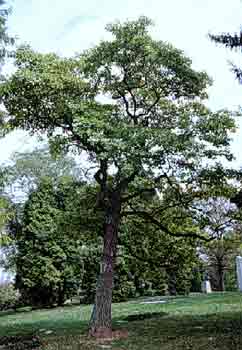 Sassafras - Sassafras albidum
Sassafras - Sassafras albidum
Laurel Family (Lauraceae)
- Native habitat: Maine west to Michigan, south to Texas and Florida.
- Growth habit: Pyramidal, irregular form when young, becoming oval and irregular at maturity. Sassafras suckers freely and often forms thickets.
- Tree size: Reaches a height of 30 to 60 feet with a spread of 25 to 40 feet.
- Flower and fruit: Yellow male and female flowers appear early on separate trees. Female trees produce dark blue berries on red stems.
- Leaf: The 3- to 7-inch leaves have three shapes: unlobed, fork-like two-lobed and mitten-like one-lobed. The bright green, aromatic leaves turn yellow to deep orange to red and purple in fall.
 Hardiness: Winter hardy to USDA Zone 4.
Hardiness: Winter hardy to USDA Zone 4.
The laurel family contains many aromatic tree and shrub genera from the tropical and warm temperate regions of the world. Although fossil records show sassafras once was widely distributed throughout the Northern Hemisphere, only two species currently exist: our native American species and an east Asian species.
The name sassafras was derived from the Spanish word salsafras, referring to the tree's alleged medicinal value. The specific epithet, albidum, refers to the light or whitish color of the undersides of leaves.
 Oil extracts of sassafras roots and bark were used extensively by Native Americans, and the first European explorers felt sure sassafras was the miracle cure-all of the New World.
Oil extracts of sassafras roots and bark were used extensively by Native Americans, and the first European explorers felt sure sassafras was the miracle cure-all of the New World.
The Creole spice filé includes dried sassafras leaves ground to a fine powder. It gives gumbo its unique consistency.
 Sassafras roots exude chemicals that may kill other plants within its root zone (allelopathic).
Sassafras roots exude chemicals that may kill other plants within its root zone (allelopathic).
Starting as early as 1584 English explorers were sent to the New World to locate and procure sassafras. Although its medicinal value proved disappointing, oils extracted from the spicy, pleasant-tasting root bark and twigs have been used to flavor tea, root beer and candy and for scenting perfume and soap. However, the oil contains safrole, which has been shown to be carcinogenic in rats and mice. The Food and Drug Administration has prohibited the use of oil of safrole and sassafras bark in food, but permits use of edible spices, which contain very small amounts of safrole.
 Large nursery stock and trees collected from the wild do not transplant well. Container-grown nursery stock is preferred for transplanting. An alternative is to collect and grow sassafras from seed or root cuttings and transplant while still relatively small.
Large nursery stock and trees collected from the wild do not transplant well. Container-grown nursery stock is preferred for transplanting. An alternative is to collect and grow sassafras from seed or root cuttings and transplant while still relatively small.
Sassafras is common in Kentucky and is one of the first trees to grow in abandoned fields (with the help of visiting birds that love to eat the tree's fruit). Owensboro, Ky., is home to the national champion, a 78-foot-tall sassafras with a 69-foot spread.


